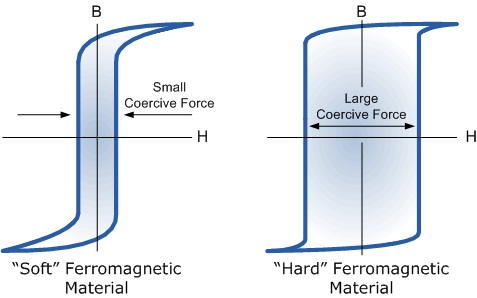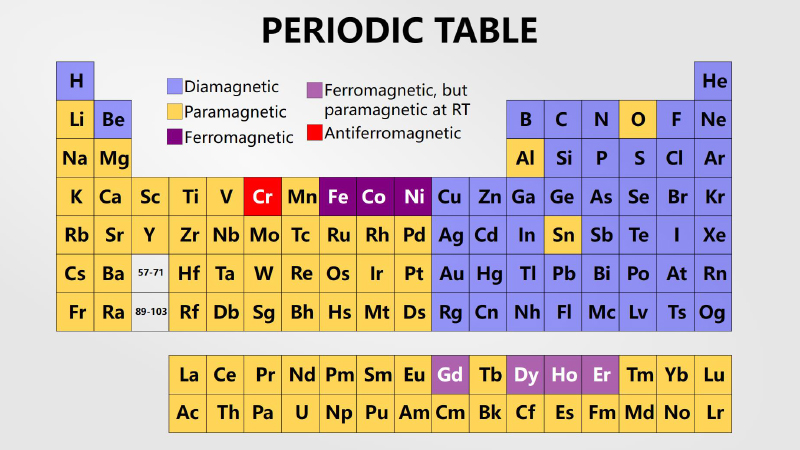Ferromagnetism (and its close counterpart, ferrimagnetism) is the strongest of the four types of magnetism. The other three—paramagnetism, diamagnetism, and antiferromagnetism—are too weak to be detected without special laboratory equipment.
Ferromagnetism is a property found in some materials (e.g., iron) that gives rise to a large observed magnetic permeability and, frequently, a correspondingly sizeable magnetic coercivity allowing the formation of permanent magnets.
Metals noticeably attracted to a magnet due to their large magnetic permeability are called ferromagnetic materials.
Examples of Ferromagnetic Materials
Ferromagnetic materials are attracted to magnets. They don’t create their magnetic field; only magnets can do that. Ferromagnetic materials pull themselves towards existing magnets because of the strength of the attraction.
The most well-known ferromagnetic materials are metals like iron, nickel, and cobalt, as well as alloys of rare-earth metals. Here are a few examples:
- Iron is the namesake of all ferromagnetic metals. You might not realize it, but you likely have iron-based magnets in your home, such as those on your refrigerator door.
- Cobalt is a ferromagnetic element that can be magnetized and create permanent magnets. This magnetic property makes cobalt an ideal material for many applications – from those we commonly use in our homes to heavy industry machinery.
- Nickel is third on the list of ferromagnetic metals. It strengthens steel alloys, mainly stainless steel. Additionally, its natural magnetism is valuable in other materials like alnico (an alloy made of aluminum-nickel-cobalt)
- Rare earth metals can be magnetized to create magnets. Neodymium (Nd-Fe-B) and samarium cobalt (SmCo) are two of the most well-known types of rare earth metals.
To learn more about magnetic and non-magnetic metals, click here.
Properties of Ferromagnetic Materials
- Ferromagnetic substances have atoms with permanent dipole moments present in domains.
- Ferromagnetic substances are materials in which the atomic dipoles tend to point in the same direction as an external magnetic field.
- The magnetic dipole moment is sizeable and points in the same direction as the magnetizing field.
- Saturation is determined by the material composition and how it reacts to magnetization. The stronger the magnetic field, or (H), the greater the magnitude of magnetization (M).
- Magnetic susceptibility is the ratio between the intensity of magnetization and the strength of an applied magnetic field. The value is usually positive and massive.
- The magnetic flux density, or the strength of the magnetic field, will be huge and positive. Ferromagnetic materials have an intense concentration of magnetic field lines. The formula for calculating magnetic flux density is B =ε0(H + M), where ε0 is the constant representing the free space permeability in a vacuum, H stands for applied magnetism outside the material we are measuring, and M means how intensely magnetized our sample material is.
- The permeability of a ferromagnet is significantly larger than that of other materials and increases directly with the magnetizing field. The strength of the magnetizing field inside the material is much greater than that outside, so ferromagnets pull in a large number of lines of force.
- When placed in a nonuniform field, ferromagnetic substances are attracted to the poles where the magnetic force is strongest.
- If you place a ferromagnetic powder on a watch glass between two opposite poles, the powder will be pulled to the sides because the field is stronger.
- When ferromagnetic materials are melted, they lose their Properties related to magnetism because the temperature is too high.
This video does an excellent job of explaining ferromagnetism.
Types Of Ferromagnetic Materials
There are two types of ferromagnetic materials: “hard” materials that remain magnetic and “soft” materials that can be magnetized but don’t stay Magnetized.
Hard Magnetic Materials
A hard magnetic material is a material that has high magnetic permeability and can retain a magnetic field for long periods of time. These materials are not easily magnetized or demagnetized, and they are often used in applications where a strong and stable magnetic field is required.
Here is a short list of hard magnetic materials:
- Neodymium
- Dysprosium
- Samarium-cobalt
- Alnico (an alloy of aluminum, nickel, and cobalt)
- Iron-platinum
- Iron-chromium-cobalt
These materials are commonly used in the construction of permanent magnets, which are used in a wide range of applications, from small motors to loudspeakers to MRI machines. Hard magnetic materials are also often used in magnetic data storage devices, such as hard drives and tapes.
Soft Magnetic Materials
Soft magnetic materials are materials that have a high magnetic permeability and a low magnetic coercivity. This means that they are easily magnetized and can quickly reach a high magnetic state in response to an applied magnetic field. However, they also quickly lose their magnetization when the applied magnetic field is removed.
Here is a short list of soft magnetic materials:
- Iron
- Nickel
- Cobalt
- Steel (an alloy of iron and carbon)
- Permalloy (an alloy of iron and nickel)
- Electrum (an alloy of gold and silver)
These materials are easily magnetized and demagnetized, and they have low magnetic permeability. As a result, they are often used in applications where the magnetic field needs to be quickly and easily controlled, such as in electric motors, generators, and transformers. Soft magnetic materials are also commonly used in the construction of electrical components because of their ability to easily switch between a magnetized and demagnetized state.

Application of Ferromagnetic Materials
Ferromagnetic materials have many industrial applications. They are used in devices like electric motors, generators, transformers, telephones, loudspeakers, and credit cards’ magnetic stripes.
A daily-life example of a permanent magnet created from a ferromagnetic material can be found in a refrigerator magnet.
The refrigerator magnet is a familiar household example of a magnet made from ferromagnetic materials. This magnet type is commonly used to hold notes or other objects onto a refrigerator door. The attraction between magnets and ferromagnetic materials like iron has been said to produce “the quality of magnetism,” which was first discovered thousands of years ago and still holds today.
Frequently Asked Questions on Ferromagnetic Materials
What is paramagnetic?
A paramagnetic material only weakly responds to a magnetic field. It is pulled towards magnets but not as strongly as ferromagnetic materials. Aluminum is an example of a paramagnetic material.
What is diamagnetic?
Diamagnetic materials are those that repel magnets. They don’t exhibit any attraction to magnets. Rather, diamagnetic materials have the opposite response: they repel in the presence of a magnetic field.
What is the difference between a ferromagnetic material and a paramagnetic material?
Firstly, ferromagnetic materials are strongly attracted to magnets, while paramagnetic materials are weakly affected.
Secondly, ferromagnetic materials are attracted to magnets’ north and south poles, while paramagnetic materials only adhere to one pole.
What is the Curie temperature of a ferromagnetic material?
The Curie temperature is the temperature at which a ferromagnetic material loses its ferromagnetic properties and becomes paramagnetic. Above the Curie temperature, the material is no longer able to be magnetized.
What is the magnetic permeability of a ferromagnetic material?
Magnetic permeability is a measure of a material’s ability to support the formation of a magnetic field within itself. Ferromagnetic materials have a high magnetic permeability, which means that they can easily support the formation of a magnetic field.
Can ferromagnetic materials be magnetized in any direction?
Yes, ferromagnetic materials can be magnetized in any direction. This is one of the key characteristics that makes them useful in a wide range of applications.
Are ferromagnetic materials conductive?
Some ferromagnetic materials, such as iron and steel, are conducive. This makes them useful in applications where both magnetic and electrical properties are important, such as in electric motors and generators. Other ferromagnetic materials, such as neodymium and dysprosium, are not conducive.
Hysteresis
If you remove a ferromagnetic material’s external magnetic field, it won’t completely lose its magnetization. You must apply a magnetic field in the opposite direction to bring it back to zero magnetization. This property of ferromagnetic materials retaining some magnetization after the external field is removed is called hysteresis. If you’re interested in learning more about hysteresis, click here.
Conclusion
Ferromagnetic materials are a type of material that exhibits strong magnetic properties. These materials can create powerful magnets, which have various applications in industrial and consumer products. If you’re interested in learning more about our strong permanent magnets or want to find out how to use them in your projects, please get in touch with us today. We would be happy to discuss our products with you and answer any questions you may have.

